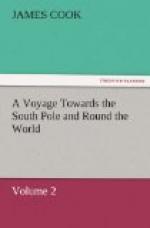At four in the morning of the 16th we wore and stood to the east, with the wind at S.S.E., a moderate breeze, and fair; at eight o’clock saw the land extending from E. by N. to N.E. by N.; loosed a reef out of each top-sail, got top-gallant yards across, and set the sails. At noon observed in latitude 54 deg. 25’ 1/2, longitude 38 deg. 18’ W. In this situation we had one hundred and ten fathoms water; and the land extended from N. 1/2 W. to E., eight leagues distant. The northern extreme was the same that we first discovered, and it proved to be an island, which obtained the name of Willis’s Island, after the person who first saw it.
At this time we had a great swell from the south, an indication that no land was near us in that direction; nevertheless the vast quantity of snow on that in sight induced us to think it was extensive, and I chose to begin with exploring the northern coast. With this view we bore up for Willis’s Island, all sails set, having a fine gale at S.S.W. As we advanced to the north, we perceived another isle lying east of Willis’s, and between it and the main. Seeing there was a clear passage between the two isles, we steered for it, and at five o’clock, being in the middle of it, we found it about two miles broad.
Willis’s Isle is an high rock of no great extent, near to which are some rocky islets. It is situated in the latitude of 54 deg. S., longitude 38 deg. 23’ W. The other isle, which obtained the name of Bird Isle, on account of the vast number that were upon it, is not so high, but of greater extent, and is close to the N.E. point of the main land, which I called Cape North.
The S.E. coast of this land, as far as we saw it, lies in the direction of S. 50 deg. E., and N. 50 deg. W. It seemed to form several bays or inlets; and we observed huge masses of snow, or ice, in the bottoms of them, especially in one which lies ten miles to the S.S.E. of Bird Isle.
After getting through the passage, we found the north coast trended E. by N., for about nine miles; and then east and east-southerly to Cape Buller, which is eleven miles more. We ranged the coast, at one league distance, till near ten o’clock, when we brought-to for the night, and on sounding found fifty fathoms, a muddy bottom.
At two o’clock in the morning of the 17th we made sail in for the land, with a fine breeze at S.W.; at four, Willis’s Isle bore W. by S., distant thirty-two miles; Cape Buller, to the west of which lie some rocky islets, bore S.W. by W.; and the most advanced point of land to the east, S. 63 deg. E. We now steered along shore, at the distance of four or five miles, till seven o’clock, when, seeing the appearance of an inlet, we hauled in for it. As soon as we drew near the shore, having hoisted out a boat, I embarked in it, accompanied by Mr Forster and his party, with a view of reconnoitring the bay before we ventured in with the ship. When we put off from her, which was about four miles from the




